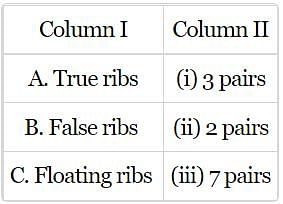Test: Skeletal System (NCERT) - NEET MCQ
25 Questions MCQ Test Biology Class 11 - Test: Skeletal System (NCERT)
In an adult human, how many bones are present as ear ossicles?
The cervical vertebra called axis provides head with sideways rotation. This can be because
| 1 Crore+ students have signed up on EduRev. Have you? Download the App |
Humerus with Its rounded upper end (head) articulates into:
Acromion process is characteristically found in the __________ of mammals.
A cricket player is fast chasing a ball in the field. Which one of the following groups of bones are directly contributing in this movement?
Which of the following bones form a link between axial and appendicular skeleton?
Out of the following pairs of the human skeletal parts, identify the wrongly matched pair
The coxal of the pelvic girdle is formed by the fusion of
Which of the following statements are incorrect regarding a normal human?
(i) The skull is dicondylic.
(ii) Metacarpals are five in numbers.
(iii) Patella is a cup-shaped bone covering the knee dorsally.
(iv) Scapula is a large triangular flat bale, situated on the ventral side of the thorax.
(v) The pelvic girdle has two coxal bones.
Human vertebral column consists of 33 vertebrae and ________ bones
11th and 12th pair of ribs which are imperfectly formed and do not reach the sternum are called
Which of the following is not a function of vertebral column?
The figure given here is of rib cage. Identify the parts labelled as A, B and C and select the correct option.

Consider the following four statements (i) - (iv) and select the correct option.
(i) Actin is present in thin filament.
(ii) H-zone of striated muscle fibre represents both thick and thin filaments.
(iii) There are 11 pairs of ribs in man.
(iv) Sternum Is present on ventral side of the body.
Match column I with column II and select the correct option from the codes given below.

|
182 videos|365 docs|153 tests
|

















